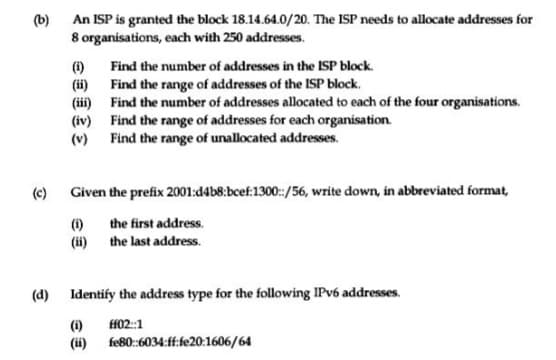(b) An ISP is granted the block 18.14.64.0/20. The ISP needs to allocate addresses for 8 organisations, each with 250 addresses. Find the number of addresses in the ISP block. (1) (ii) Find the range of addresses of the ISP block. (ii) Find the number of addresses allocated to each of the four organisations. (iv) Find the range of addresses for each organisation. (v) Find the range of unallocated addresses. (c) Given the prefix 2001:d4b8:bcef:1300:/56, write down, in abbreviated format, (1) the first address. (ii) the last address. (d) Identify the address type for the following IPV6 addresses. (1) H02:1 (i) fe80:6034:ff:fe20:1606/64
(b) An ISP is granted the block 18.14.64.0/20. The ISP needs to allocate addresses for 8 organisations, each with 250 addresses. Find the number of addresses in the ISP block. (1) (ii) Find the range of addresses of the ISP block. (ii) Find the number of addresses allocated to each of the four organisations. (iv) Find the range of addresses for each organisation. (v) Find the range of unallocated addresses. (c) Given the prefix 2001:d4b8:bcef:1300:/56, write down, in abbreviated format, (1) the first address. (ii) the last address. (d) Identify the address type for the following IPV6 addresses. (1) H02:1 (i) fe80:6034:ff:fe20:1606/64
Computer Networking: A Top-Down Approach (7th Edition)
7th Edition
ISBN:9780133594140
Author:James Kurose, Keith Ross
Publisher:James Kurose, Keith Ross
Chapter1: Computer Networks And The Internet
Section: Chapter Questions
Problem R1RQ: What is the difference between a host and an end system? List several different types of end...
Related questions
Question
100%
Kindly answer all priority is first part

Transcribed Image Text:(b)
An ISP is granted the block 18.14.64.0/20. The ISP needs to allocate addresses for
8 organisations, each with 250 addresses.
Find the number of addresses in the ISP block.
(1)
(ii) Find the range of addresses of the ISP block.
(iii) Find the number of addresses allocated to each of the four organisations.
(iv) Find the range of addresses for each organisation.
(v) Find the range of unallocated addresses.
(c) Given the prefix 2001:d4b8:bcef:1300:/56, write down, in abbreviated format,
the first address.
(1)
(ii) the last address.
(d) Identify the address type for the following IPV6 addresses.
ff02::1
(1)
(ii) fe80:6034:ff:fe20:1606/64
Expert Solution
This question has been solved!
Explore an expertly crafted, step-by-step solution for a thorough understanding of key concepts.
Step by step
Solved in 2 steps with 3 images

Recommended textbooks for you

Computer Networking: A Top-Down Approach (7th Edi…
Computer Engineering
ISBN:
9780133594140
Author:
James Kurose, Keith Ross
Publisher:
PEARSON

Computer Organization and Design MIPS Edition, Fi…
Computer Engineering
ISBN:
9780124077263
Author:
David A. Patterson, John L. Hennessy
Publisher:
Elsevier Science

Network+ Guide to Networks (MindTap Course List)
Computer Engineering
ISBN:
9781337569330
Author:
Jill West, Tamara Dean, Jean Andrews
Publisher:
Cengage Learning

Computer Networking: A Top-Down Approach (7th Edi…
Computer Engineering
ISBN:
9780133594140
Author:
James Kurose, Keith Ross
Publisher:
PEARSON

Computer Organization and Design MIPS Edition, Fi…
Computer Engineering
ISBN:
9780124077263
Author:
David A. Patterson, John L. Hennessy
Publisher:
Elsevier Science

Network+ Guide to Networks (MindTap Course List)
Computer Engineering
ISBN:
9781337569330
Author:
Jill West, Tamara Dean, Jean Andrews
Publisher:
Cengage Learning

Concepts of Database Management
Computer Engineering
ISBN:
9781337093422
Author:
Joy L. Starks, Philip J. Pratt, Mary Z. Last
Publisher:
Cengage Learning

Prelude to Programming
Computer Engineering
ISBN:
9780133750423
Author:
VENIT, Stewart
Publisher:
Pearson Education

Sc Business Data Communications and Networking, T…
Computer Engineering
ISBN:
9781119368830
Author:
FITZGERALD
Publisher:
WILEY